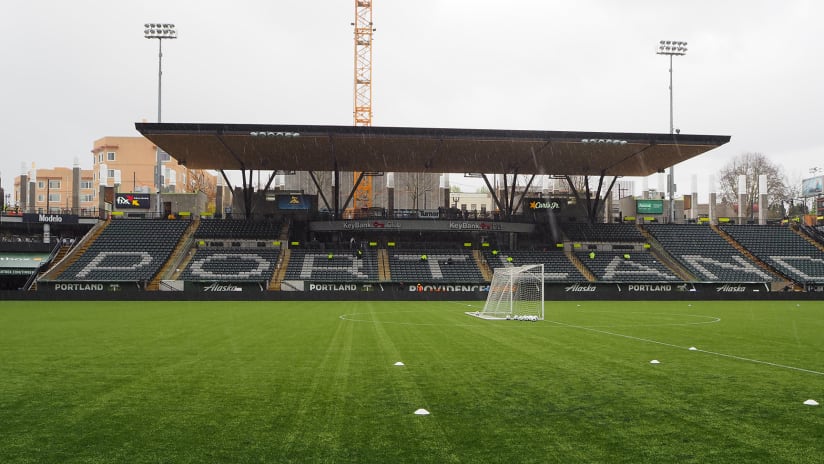In the middle of the day, when its only inhabitants are employees behind closed doors or working to get the concourse ready for match day and Minnesota United down on the pitch for practice, Providence Park in Portland is not an overwhelming building. It sits below street level, so you go down into it, and it feels every bit the neighborhood park. Approaching it is not unlike approaching Fenway in Boston. It doesn’t tower, it feels like it grows organically from the ground. It has a lived-in feel, a careworn element that is impressive simply because it’s not something you can build into a stadium. It has to be lived into it.
“Stadium” doesn’t even feel like the right term. It’s immediately clear why it’s called a “park” and it inhabits and embodies that word. From the surface of the pitch as the sky cycles from gray to blue and sprinkles come and go, the bones of the minor league baseball park it once was are clearly evident. Seats rise in a tidal wave on the north end and wrap to the west, angled around what must have once been home plate, but elsewhere they rise and fall in unpredictable ways, with wedges of seats tucked here and there. There’s the Multnomah Athletic Club on the south end, its imposing gray wall rising up and affording members an enviable view of Timbers and Thorns matches from astride their exercise bikes. But don’t get your hopes up: the club’s membership is limited to 17,158 residents and the waiting list is long.
As the rain picks up again, it’s obvious the overhanging eaves are a necessity in Portland’s climate, and they’re striking, not because of how high tech they are, but how low tech. They’re wooden and painted unevenly and you can see the grain and wear on them. It points, again, to that minor league ballpark legacy — a powerful reminder that there are things you can plan and then things you adapt to. The well over 100-year-old stadium has gone through so many changes along the way where some things were kept and others cut away. Each decision was made for reasons that were no doubt argued and debated and are now forgotten. Even now, they’re working to add capacity to the stadium and by this time next year, it will look different again, more modern. Yet its thisness — for lack of a better word — will still be unmistakable.
It’s no secret that Allianz Field aspires to that same level of thisness or place or whatever you want to call it. The pace at which Allianz Field is coming together can be astounding, but it remains a little hard to believe that there will be soccer being played there less than a year from now. Elements are being installed that will eventually have to change. Things will be added, things will be removed. When you’re building a stadium meant to last for decades and even generations, change is all but inevitable. That change is, oddly, a part of that feeling of permanence.
We like to think that what endures is true — that what time reveals as the rest falls away was what was true from the beginning. But it’s more complicated than that. What endures endures, and we make truth out of that. That’s resilience.


